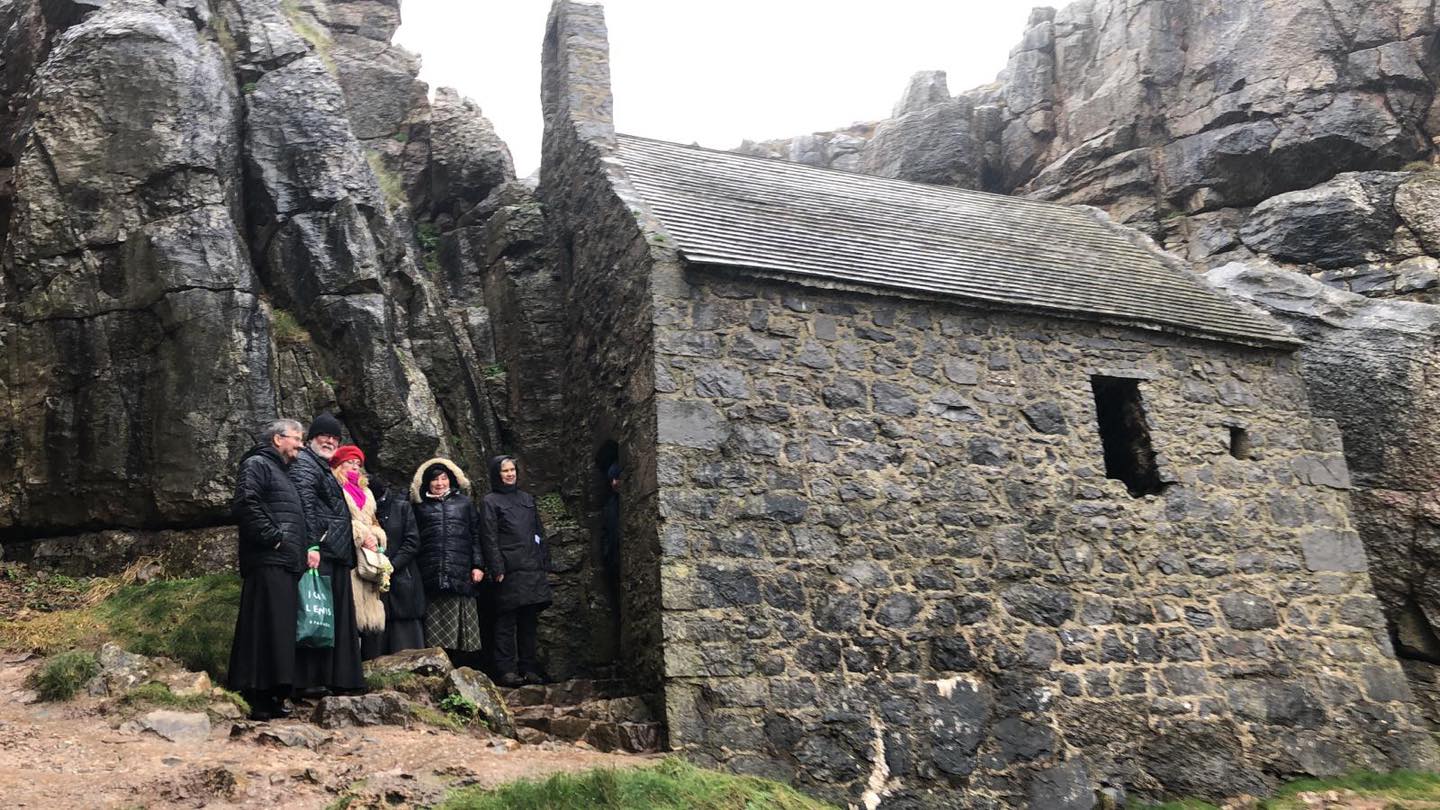
From 11-14 February 2024, with the blessing of His Grace Bishop Matthew, a group of nearly 30 parishioners of St Nicholas Church in Oxford made a pilgrimage to some of the holy places of South Wales.
The group set off after the Sunday Liturgy, making their first stop at Caerleon on Usk, the place of martyrdom of Sts Julius and Aaron, Protomartyrs of Wales (+3rd century). A short molieben was served at the site of the Roman amphitheatre, the supposed place of their martyrdom, and there was time to explore the excellent Roman museum. We went on to spend the first night in Cardiff.
On the morning of Monday 12th February, the group first visited the historic Greek Orthodox Church of St Nicholas in Cardiff, built by Greek sailors and merchants over 100 years ago. We were warmly welcomed by the parish priest, Archimandrite Nicholas, who told us about the history of the church and offered a reliquary with a part of the relics of St Nicholas for veneration.
Our next stop was the ancient Llandaff Cathedral, where we served a molieben before the relics of St Teilo (+560), cousin of St David of Wales and wonderworker, who founded many monasteries and churches in the region. We were met by Fr Jacob Siemens of the Archdiocese of Russian Orthodox Parishes in Western Europe, who told us more about this holy place.
The afternoon began with a visit to St Fagans museum of Welsh life, which includes an ancient church of St Teilo, moved from elsewhere and decorated with a reconstructed early scheme of wall paintings. This was followed by prayers at St Illtyd’s church in Llantwit Major, in the newly restored Galilee chapel, which holds a fine collection of ancient stone crosses. Here we were joined by Hegumen Deiniol, Dean of our diocesan deanery district of Wales, who stayed with us for the rest of the programme and provided invaluable support and guidance to our pilgrims.
Our last visit of the day was to Penrhys. Here, high above the Rhonda valleys, enormous numbers of pilgrims once came to venerate a miraculous image of the Mother of God, discovered by children in a tree, some time in the eleventh century. The holy well which appeared at that time still exists, and we visited and prayed there. Before departing for our hotel, Fr Deiniol took us to visit his friends at a local church, who offered us tea and told us of their important social ministry in the area, which is extremely deprived.
Tuesday 13th February began with a visit to the chapel of St Govan (+586), hidden in an isolated cleft in the cliffs on the sea coast in Pembrokeshire. St Govan lived here as a hermit in a cave located behind the chapel, and his relics rest beneath the altar. By tradition, the cave once closed around him to protect him from pirates.
In the early evening we arrived at our ultimate destination - St Davids Cathedral, where we were welcomed by the Dean, Dr Sarah Rowland Jones. We were invited to serve vespers at the shrine of St David (512-587), after which Dean Sarah told us about the life and legacy of St David. We venerated the shrine and the relics it contains and were able to spend some time in quiet prayer and contemplation.
Our final day, Wednesday 14th February, began with a visit to the ruined chapel and holy spring of St Non, the mother of St David. Here, according to tradition, St Non has given birth to St David in. miraculous way, protected from a fierce storm. Many healings still occur at the holy spring.
After a final molieben in a beautiful little modern chapel of St Non that stands nearby, built from the stones of her original shrine, our pilgrim group began the long journey back to Oxford, arriving in time to serve the vigil for the great feast of the Meeting of the Lord.
A few of those who had travelled in their own cars were able to make a stop at the church of St Issui, another early welsh monastic saint, whose cell still exists, adjoining the church, with his relics buried beneath the altar and his holy well nearby.
Archpriest Stephen Platt
 14-02-2024
14-02-2024  From 11-14 February 2024, with the blessing of His Grace Bishop Matthew, a group of nearly 30 parishioners of St Nicholas Church in Oxford made a pilgrimage to some of the holy places of South Wales.
From 11-14 February 2024, with the blessing of His Grace Bishop Matthew, a group of nearly 30 parishioners of St Nicholas Church in Oxford made a pilgrimage to some of the holy places of South Wales.





